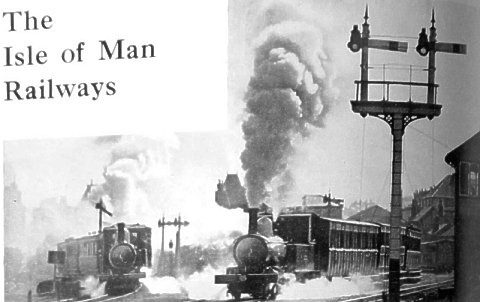
From The Railway Magazine pp310/315 December 1941

Trains leaving Douglas, Isle of Man Railway
IT was in the November, 1927, issue of THE RAILWAY MAGAZINE, that the last extended reference appeared to the railways of the Isle of Man ; this was an article by the late Mr. H. L. Hopwood. Since then, although few changes of any note have taken place in the island railways, various minor developments recorded in letters from readers are worthy of note.

In proportion to its modest size, which is about equal to the Isle of Wight, Anglesey, or Arran, the Isle of Man can pride itself on an extent and variety of railway activity hat is quite exceptional. It possesses four different railways : first, the main island steam-worked system on the 3 ft. gauge, then the Manx Electric Railway and its Snaefell Mountain Railway subsidiary, and, last, the small steam-worked 2 ft. gauge line in Groudle Glen. Douglas, with 40,000 inhabitants, is easily the largest town ; Peel and Ramsey are small fishing towns ; and Castletown, Port St. Mary, Port Erin, and Laxey are large holiday villages. The north of the island is a flat plain with a sparse population evenly spread out ; south of the railway from Ramsey to Kirkmichael the hills rise, almost precipitously at first, to Snaefell, North Barrule, and other summits. The mountains continue southwards down the length of the island except for the wide natural gap through which pass the railway and the road from Douglas to Peel. Escept from Peel along the west and north coast round to Ramsey, the island is encircled by cliffs, broken into by a number of deep glens which have been scooped out of the mountain mass-the chief of these is the glen leading down to Laxey - and this configuration results in very heavy gradients on the coastal railways and roads.
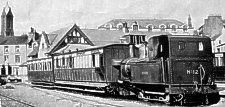 Douglas train at Peel headed by 2-4-0 locomotive No. 12 " Hutchinson,'' |
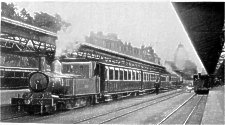 Ramsey and Peel train at Douglas with 2-4-0 locomotive No. 13'' Kissack " (Port Erin train on right |
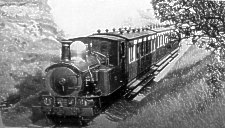 Douglas-Port Erin train near Castletown with 2-4-0 locomotive No 16 "Mannin" |
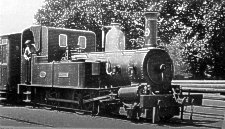 No 9 "Douglas" at Ballaugh, Isle of Man Railway |
Douglas is the main gateway to the island, and the island communications
radiate from this centre; so far as concerns the railways, these are the main
line of the Isle of Man Railway across to Peel, with a branch from St. John's
round the west coast and the north of the island to Ramsey, and a short branch
from St. John's to Foxdale ; the south-west coastal line from Douglas to Port
Erin ; and the Manx Electric Railway along the east coast from Douglas to Ramsey,
with which the Snaefell Mountain Railway connects at Laxey
Mr. D. S. Barrie writes of the heavy traffic conveyed in the years immediately
before the war by the Isle of Man Railway over its 46.25 miles of line, despite
increasing road competition - in 1937, for example , this amounted to over 775,000
passengers and 56,100tons of freight---and the same fact is stressed in an interesting
cutting from the Isle of Man Weekly Times sent by Mr. R.N.Marshall. The
newspaper devoted almost an entire page, headed by a striking Photograph of
the "Cock o' the North " and the Port Erin Flyer leaving; Douglas
simultaneously (reproduced at the head of this article), to a description of
journeys by these two trains laying emphasis on the fact that the traveller
by road missed some of the best scenery and that the trains were faster than
the buses.
Both the trains mentioned normally ran in the season only. The former was booked
to leave Douglas at 10.5a.m., and to cover the 25 miles of 3ft. gauge from Douglas
to Ramsey in the even hour, with two intermediate stops, as compared with 75
min. by stopping trains and 70 min. by the buses. The stops were at St. John's,
to detach a portion for Peel, and at Kirkmichael, to cross a train from Ramsey
to Douglas. Passenger trains throughout the island are still hauled by the small
Beyer, Peacock 2-4-0 tanks, 15 in number, and Mr. Barrie mentions a run with
No. 13, Kissack, hauling a 45-ton train, on which an average speed of
41 m.p.h. was maintained for over a mile, with a maximum of 45 m.p.h. Excluding
the time spent in standing at eight intermediate stops, the running time on
the 25-mile Douglas-Ramsey journey was exactly one hour. This was excellent
going for an engine with 11in by 18 in cylinders, 3ft 9in driving wheels, 461
sq ft of heating surface, 160 lb pressure, and a weight of only 29/5 tons. The
ruling gradient on the Ramsey line is 1 in 100.
A subsequent introduction was the seasonal Port Erin Flyer, at first non-stop from Douglas to Port Erin, but later with an additional stop at Port St. Mary ; the 15.5 miles were covered in 40min., or 10 min less than the journey time od dstopping trains, Port St. Mary being reached in 37 min. This liner has considerably steeper gradients ; from Douglas to Port Soderick there is a climb for 3 miles at 1 in 65-70, followed by a long descent to Ballasalla. According to the newspaper account, the maximum number of passengers conveyed by the Port Erin Flyer on a busy day was 800, and the preference for the rail is not surprising, seeing that the bus journey from Douglas to Port St. Mary is scheduled to take 70 min. The railway travel habit has been encouraged by the issue of season tickets during the summer, giving "the freedom of the island" by rail for various periods from two to seven days at a charge of 5s to 10s. Incidentally the railway company holds a controlling interest in the Isle of Man road Servicesa Limited - a subsidary company owning 82 road vehicles, so that revenue from either source is valuable.
Mr Barrie mentions that in recent years the short branch from St. John's to Foxdale has sprung into renewed activity owing to the demand for slag and waste material from the derelict Foxdale silver lead mines; during two recent winters 50,000 tons of this material were brought down to Douglas and tipped to form a site for building development. For working the mineral trains over the heavy grades of the Foxdale branch, which for 2¾ miles rises at 1 in 49, the 0-6-0 tank No 15, Caledonia - originally owned by the Manx Northern Railway and the only six-coupled engine in the island - has been used. The slag traffic from Foxdale passes only in the winter months. It may be added that the Isle of Man Railway owns 115 coaches, 175 wagons, and 14 road freight vehicles.
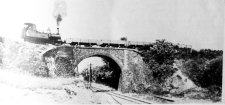
Train on Foxdale branch crossing main line I of M R
2-4-0 locomotive No 1 leaving for Foxdale
The foregoing information in regard to operation, particularly of the express trains, was supplied before the war ; in common with the mainland systems, the I.O.M. Railway has necessarily modified its services to meet war conditions. During the summer of 1940 the Ramsey and Peel lines have been served by seven weekday trains from, and six to, Douglas, with an additional early morning service from Kirkmichael into Ramsey, and certain Saturday extras. The Port Erin service has comprised seven week-day trains each way, and one or two extra Saturday trains. According to our information, the same service has been maintained during the Summer as in the Winter, doubtless owing to the virtual elimination of holiday traffic to the Island. The Foxdale branch enjoys the same service (one morning mixed train each way only) as as has been provided for a considerable time on this section, which is primarily served by Buses -the latter, incidentally, being shown in Bradshaw.
The outbreak of war created a very difficult position for the Isle of Man Railway
Company. In a normal year the profit made during the summer season is more than
sufficient to cover the loss at which the services are worked during the remainder
of the year, but in war conditions the crowds of holidaymakers from Lancashire
and elsewhere are absent. The result has been that in 1941 the receipts dropped
by £16,417, a decrease of one-third, of -which passenger traffic accounted
for £12,960, whereas it was possible to cut -working expenses only by
£6,364. There was a slight recovery in the latter part of the year, but
the year was closed with a debit balance of £5,817. At the 1941 annual
meeting of the company, held on March 12 last, the chairman, Mr R. Q. Harnpton,
recalled that the Railway Regulation Act of 1878 provides that it shall be lawful
for the Court of Tynwald, with the approval of the Isle of Man Treasury, by
resolution to guarantee, on such terms and conditions as may be considered desirable,
that the gross or net revenue of the railway, as a public utility undertaking,
shall be made up to a certain fixed amount, as a charge on the general revenue
of the island, in much the same way as the British Government guarantees to
British railways, in wartime, a minimum net revenue based on the average earnings
from 1935 to 1937. The management of the Isle of Man Railway has therefore approached
the Manx Government with a request that the provisions of the 1879 Act may be
put into operation, and the War Committee of Tynwald has the matter under consideration.
Another possible solution of the difficulty is the War (Local Conditions) Act,
which has been passed by the Manx legislature to give financial assistance to
businesses dependent on industry, so that they are maintained in readiness for
immediate resumption after the war, by grants to cover working loss or debenture
interest. In any event it is hoped to keep the island railways efficiently at
work.
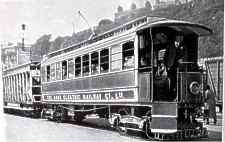
Ramsey train at Douglas, Manx Electric Railway
Some further notes, from Mr. Leonard Hobday, concern the Manx Electric Railway, which serves the eastern side of the land, by means of an 18-mile route of 3 ft. gauge between Douglas and Ramsey. Including all stops the schedule allowance is 75 min., and when the extremely heavy gradients and sharp curvature are taken to account, the overall average of 14.5 m.p.h. becomes more creditable than might appear at first sight. The first 2-mile out of Douglas, for example, up on to Onchan Head, is at l in 24, and in the sharp switchback of gradients, which includes seven well-defined summits on the high ground, and descents almost to sea level at Baldrine and Laxey,inclinations between 1in 24 and 27 are frequuent. Current at 550volts is taken from overhead conductors, and the singledeck cars, of which the motorcars weigh 10 tons and the trailers 6tons, are used singly or in pairs as traffic requires. Scenery along the line is very fine, with the views of Douglas Bay, Laxey Bay, Maughold Head and Ramsey Bay, as well as inland of Maughold Head.
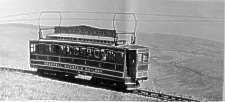
Car near summit of Snaefell (2034 ft) Snaefell Mountain Railway
The Snaefell Mountain Railway, from Laxey to the summit of Snaefell,
2034 ft above the sea, has a ruling gradient of 1 in 12 and is worked by single
cars, which are not allowed to exceed a s[peed of 6 to 7 m.p.h. while ascending
or descendin. In all the Max Electric (including the Snaefell Mountain Railway)
owns 30 motorcars, 25 trailers, 8 mail vans, 18 wagons, a motor for freight
working, and several road vehicles.
Both the Manx Electric Railway and the Snaefell Mountain Railway are double-track
throughout The former runs on its own independent sleepered track, open to the
adjacent roadway for between 2 and 3 miles from Douglas, then separated from
it by a hedge, and finally making a long detour from the road on the slopes
of North Barrule, as it approaches Ramsey. At the Douglas end it suffers from
the disadvantage of a Railway starting at Derby Castle, which is 12 miles from
the centre of Douglas, so that Douglas Corporation buses must be used to bridge
the gap, apart from walking. Since the summer of 1939 traffic on the Snaefell
Mountain Railway has been suspended, and some of the overhead electric equipment
has been brought down in consequence of the exceptionally severe weather of
the two succeeding winters, but eight services in each direction daily are still
being maintained on the Manx Electric Railway.
One more independent line in the Island requires mention ; it is the Groudle Glen narrow gauge railway. This has a gauge of only 2 ft and is 0.75 mile in length, and runs froim Lhen Coar, on the seaward side of the Manx Electric Railway to Sea Lion rocks.
The Glen station, Mr W. A. Camwell writes is reminiscent of a Swiss chaley, well down theglean near the river, and in very attractive surroundings. After leaving the station the single line emerges on to open heathland, and runs well above the river to a a small distance short of the estuary where the enclosure containing the sea lions is found. Midway between the terminals is a passing loop which can be seen from the Manx Electric line. The locomotive shed is at the Glen station, and houses the two Bagnall-built outside cylinder 2-4-0 side tanks which work the line. One of these, named Sea Lion, and bearing the maker's number 1484, was built in 1898 ; the other, bearing Bagnall's number 1781, is named Polar, Bear, and is some ten years younger, About 1929, while these engines were under repair, the electric battery locomotives were in use, and caused certain otherwise reputable guide books to describe the Groudle Glen line as an electric railway. There are eight 4-wheel coaches of the open toast-rack type, but provided with roofs, and during the holiday season, usually beginning at Whitsuntide, trains are run as required on the one-engine-in-steam principle. A return fare of 1s. is charged, which includes admission to the sea lion enclosure.
The photographs reproduced include one of an electric car on the Snaefell Mountain Railway, with its comprehensive headboard carried in the centre of the roof. Mr. Barrie's photograph of Douglas terminus, Isle of Man Railways, gives a good idea of the commodious accommodation at this station, with its two long island platforms, roofed throughout their length. In the left foreground is the 2-4-0 locomotive Kissack, used on the run described, on which a speed of 45 m.p.h. was attained ; on the right is the Port Erin train.
A picture of particular interest is that of the old signal near Castletown, sent by Mr. A. R. Prince ; the arm drops out of sight into the slot in the post, when pulled off, and the lamp rotates on its spindle, as in old Brighton practice, to give the " clear " indication.
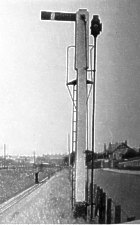
Signal near Castletown
The mechanism at the foot of the post drops the arm to vertical position in a slot in the post and also rotates the rod carrying the lamp thereby bringing the other lens into the driver's view.

Train from Douglas arriving at Port St Mary, 2-4-0 locomotive No 10, "
G H Wood", Isle of Man Railway
|
|
||
|
|
||
| Any comments, errors
or omissions gratefully received The
Editor HTML Transcription © F.Coakley , 2019 |
||